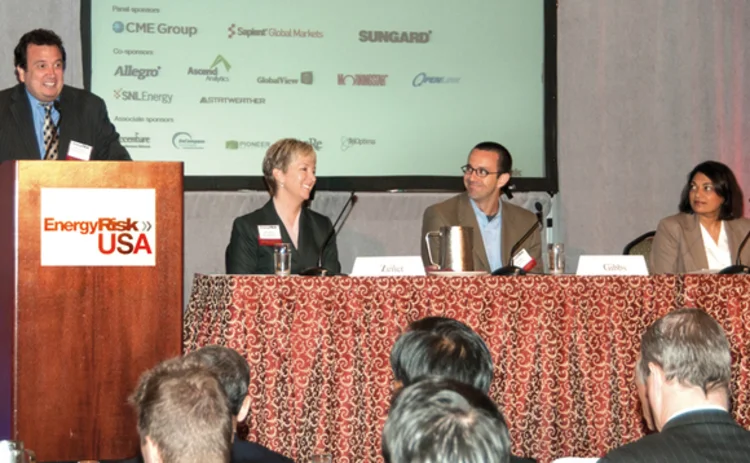
Energy Risk USA 2012
The impact of Dodd-Frank, the future of natural gas markets and the risk of extreme weather were all topics of vigorous discussion at the 2012 Energy Risk USA conference. Alexander Osipovich reports

A PDF of this article, which shows photos of speakers and panellists, is available here
More than 40 speakers from business, academia and government took the stage at the annual Energy Risk USA conference in Houston, Texas, on May 15–16. As always, the event offered risk management professionals the opportunity to hear leading thinkers discuss a range of hot-button issues affecting the US energy industry. Major issues this year included the impact of the Dodd-Frank financial reform legislation, the challenges of trading natural gas in an oversupplied market and how to hedge against extreme weather events.
Francisco Blanch, head of global commodity research at Bank of America Merrill Lynch, delivered the first keynote speech of the conference. In a lively presentation, he stressed that the boom in North American energy production was providing a significant tailwind to the US economic recovery. He also warned, however, that the glut of shale gas and oil was creating “incredible” basis risk as the transport infrastructure needed to move those hydrocarbons was not keeping up with production.
The second keynote speaker came from a distinctly different angle. Dan Berkovitz, general counsel of the US Commodity Futures Trading Commission (CFTC), defended the slow pace of the CFTC’s efforts to craft Dodd-Frank rules, insisting that the agency was just trying to get things right. Dodd-Frank has proved markedly unpopular among US energy companies, which worry that the law will make it more difficult for them to use derivatives for hedging purposes. It also provoked some of the most spirited discussions at Energy Risk USA.
Regulatory pain
The CFTC listens closely to industry feedback and is especially attentive to the concerns of hedgers, Berkovitz said. He cited the final rule on the definition of a swap dealer, issued in April, as an example of the CFTC’s responsiveness. In the initial version of that rule, the CFTC set the de minimis exception to the swap dealer definition at $100 million in annual swap trades. After an outcry from energy firms fearful of the regulatory burden that comes with being a swap dealer, the CFTC ratcheted that threshold up to $3 billion and instituted a multi-year phase-in period where the limit would initially stand at $8 billion before coming down to its final level. Now, far fewer energy companies are expected to be classified as swap dealers. “That was in response to many, many comments,” Berkowitz said.
Notably, Berkowitz said the door was open to adjusting Dodd-Frank rules even after the CFTC publishes its final version of them in the Federal Register. If compliance challenges prove too steep, or if aspects of the final rules are unclear, industry groups can seek relief by petitioning the CFTC, he noted. “It doesn’t all end with the promulgation of the final rules,” Berkovitz told the audience.
Despite such assurances, energy market participants expressed plenty of concern in the panels following Berkovitz’s speech. “There will be companies that don’t survive the Dodd-Frank implementation,” Diane Zeiler, manager for regulatory affairs at EDF Trading North America, said at a panel on the implications of Dodd-Frank for energy traders and risk managers. “We know there are a lot of companies out there that are already re-evaluating their trading business [and] origination business and adjusting those, even based on the proposed rules that we have today.”
Energy companies that use derivatives must decide whether or not they want to be swap dealers, a decision with major implications for their business, said Ike Gibbs, senior compliance officer at LDH Energy. “From a big-picture perspective, I think one of the things we can see is companies that have absolutely no interest in being swap dealers taking a good, hard look at their business activities and making decisions about whether they want to continue to do certain things that they do today,” he said. “One of the big things that we’ll see from a market perspective is just a changing landscape of who’s there and who’s doing what.”
The panellists were generally pleased with the CFTC’s decision to narrow the swap dealer definition, but Lopa Parikh, director of federal regulatory affairs for the Edison Electric Institute (EEI), a trade group representing shareholder-owned utilities, pointed out that the final rule still poses problems for one kind of industry participant: publicly owned utilities. The rule has a second de minimis threshold for trades with ‘special entities’, a category that includes state and local governments and the utilities they own. In its final rule, the CFTC left that second de minimis threshold unchanged at $25 million. That level is extremely low and will discourage other companies from doing swap trades with special entities, since doing so might force the companies to register as swap dealers, according to Parikh. “There may be some effect on how much our members are going to transact with munis based on that limit. That might push them over the de minimis threshold,” she said.
Several speakers at Energy Risk USA voiced uneasiness about the CFTC’s proposed rule on the end-user exception to the mandatory clearing of swaps. The authors of Dodd-Frank conceived the exception as a way to reduce the compliance burden for commodity firms that trade swaps to hedge commercial risk. But Parikh criticised the CFTC’s current approach to that rule as ‘unworkable’ (see news article). The CFTC is expected to issue its final rule on the end-user exception this summer.
Dodd-Frank requires most swap trades to be cleared, with the counterparties forced to transact through a central clearing house, post margin and, if they are swap dealers, meet minimum capital requirements. How will that framework affect energy companies, which prefer to execute swaps bilaterally, without posting margin? That was another important question discussed at Energy Risk USA.
Clearing will fundamentally reshape how energy firms hedge, said Patrick McCarty, managing director for government relations and regulatory affairs at Icap Energy, an inter-dealer broker for over-the-counter energy derivatives. “It’s going to drive people towards more liquid instruments,” he said at a panel on the risks and challenges of clearing. “Even if they’re not perfect hedges, I think people are going to move in the direction of saying, ‘I’ll take that 90% hedge without taking the additional cost of getting the bilateral swap in place’… Dealers may want to push things in that direction as well.”
In general, it would be safe to say that Dodd-Frank had few supporters at Energy Risk USA. At one point, the moderator of the first Dodd-Frank panel – Sid Jacobson, a partner at SunGard Global Services – asked his panellists whether they saw anything positive about the law. The question was greeted with dead silence. Then the audience laughed, and Zeiler of EDF Trading offered a suggestion: “Job security for consultants?”
One of the few speakers to say a kind word about regulation at Energy Risk USA was Andre Templeman, founder of Alpha Inception, a Houston-based advisory and consulting firm. On the second day of the conference, Templeman gave a talk about how companies can gain a strategic advantage by closely monitoring regulatory developments – particularly in clean-energy rules – and making trades based on that knowledge. The key to executing such a strategy successfully, he said, is to keep regulation experts at a company in close contact with traders and originators, and perhaps even rotate people between those roles, for the purposes of cross-pollination. “Most companies miss these opportunities because their regulatory people don’t interact with their commercial people,” Templeman said.
Whither the gas market?
The North American energy landscape has been drastically reshaped in the past couple of years by a boom in natural gas and oil production, driven by the technology of hydraulic fracturing, or fracking, which has let producers extract oil and gas from previously unreachable shale reserves. The ensuing supply glut has pushed US natural gas prices to 10-year lows, prompted utilities to switch a large swathe of generation capacity from coal to gas, and inspired plans to build terminals for the export of liquefied natural gas (LNG) from the US. All of this was fodder for discussion at Energy Risk USA, in a pair of lively panels focusing on gas trading and the LNG market, respectively.
Vince Kaminski, a professor at Rice University’s Jesse H Jones Graduate School of Management, recalled that just a few years ago, conventional wisdom held that the US needed to build LNG import terminals to make up for its supply shortfall and the natural gas market was a ‘trader’s dream’ thanks to its high volatility. “I am writing a book on energy markets,” Kaminski told the panel on gas trading, which he was moderating. “I started five years ago, and I had to rewrite the chapter on natural gas markets a few times. And in the unlikely case that my publisher is kind enough to give me five more years, I will rewrite it even more times,” he added, sparking laughter from the audience.
Meanwhile, on the LNG panel, some experts argued that the world was moving towards a globalised natural gas market, as US companies such as Houston-based Cheniere Energy Partners plan to build liquefaction terminals that would send North American shale gas to the rest of the world. “The LNG market, I think, in the end, will create an international benchmark that will equalise the prices in all the countries,” said David Lifschultz, chief executive of Genoil.
Lifschultz noted that Cheniere recently struck deals with two Asian gas companies – Korea Gas Corp. and Gail India – for the sale of LNG at prices linked to Henry Hub, the main US gas benchmark, rather than using prices linked to crude oil, which was customary in the past. “There are going to be LNG projects in countries with surplus so that they can export to countries where there is insufficiency,” he said. “And you’ll have a world market like you do in oil. I think that’s what’s coming. And I think the first major sign that you’re seeing of that, because most major producers do not want to break the linkage with oil, is Cheniere ready to break ranks and link it to Henry Hub and that these very conservative players in South Korea and India are ready to join that. It looks like that could change the entire structure of the market in natural gas.”
Echoing that argument, Jagadish Mendu, manager for LNG trading at Texas-based Excelerate Energy, said that gas companies are beginning to use LNG benchmark indexes such as Platt’s Japan/Korea Marker or the daily LNG prices published by ICIS Heren. Admittedly, trading in the LNG market is still very sporadic, with wide bid-ask spreads, but that will change if US exports move forward, said Mendu. “If the US lets liquefaction fly and it becomes a completely free market and there’s so much spot LNG that floats around, at that time these indexes will become indexes that you can really buy and sell without a dollar spread,” he said.
The third member of the LNG panel offered a gloomier viewpoint. US companies that want to export LNG should think twice before rushing to build multibillion-dollar liquefaction facilities, warned Frank Wolak, an economics professor and head of Stanford University’s programme on energy and sustainable development. With demand for natural gas in the US rising, and with countries such as China pledging to tap their own domestic shale gas reserves, the case for building costly LNG export terminals might not look as strong five years from now, when those facilities start coming online, Wolak said.
“If I was betting, I would certainly bet on what the United States is good at, which is essentially diffusion of sophisticated technologies or sources, not selling a homogenous product in a global market where that homogenous product requires you to spend a significant amount of upfront money, go through a very vigorously vetted siting process, and incur significant transportation costs to move this product and then have to have a specialised regasification facility at the other end,” Wolak said. “Just export the technology. It’s a higher margin business, and it’s something that American plants are very good at.”
Rough weather
Hurricanes, floods, tornadoes and an extraordinarily warm winter that depressed US natural gas demand: all of those were hot topics in the panel on weather risk management on the closing day of Energy Risk USA. Panellists agreed that the market for weather derivatives had received a boost from the unusual weather of the past 12 months.
Tom Paylor, a trader and meteorologist with RenRe Energy Advisors, said US companies have been been looking more closely at the weather derivatives market because of the warm winter of 2011–12. Concerned about a repeat of last winter’s warm temperatures, they are already looking into ways of hedging weather risk for next winter, moving earlier than in previous years, he said. “There seems to be a lot more interest in the weather derivatives market right now, both for power producers and natural gas producers,” Paylor told the panel.
Hurricane Irene, which caused heavy flooding along the US east coast last summer, and other big storms have also spurred interest in the market, said Lynda Clemmons, an independent weather and energy consultant based in Houston. Companies are looking at a variety of instruments to hedge storm-related risk, while insurers have stepped up their issuance of catastrophe bonds, she said. “In the past six months of cat bond issuance, the numbers have been close to $4 billion of risk that’s been hedged all over the marketplace. We have a significant amount of hedging done for pure thunderstorms, wind storms and hurricane-summer-related activity,” Clemmons said.
Extreme weather events are becoming more common and meteorologists should adjust their models to take that trend into account, argued Ria Persad, director of Statweather, a forecasting firm based in Florida. According to probabilistic models based on decades of historical data, the high temperatures of the winter of 2011–12 were extremely unlikely, with a probability of just three out of 1,000, she said. But that probability would have been significantly larger had the models given greater weight to data from the past 10 years, Parsad added.
“We have seen in the last decade some very extreme weather,” she explained. “So, based upon these types of occurrences, it changes the whole scope of what we can determine for the future… Based upon the pattern that’s been happening over time, in light of this past decade particularly, the probability of having this type of winter was actually not really a tail risk.”
Still, panellists reminded the audience that long-term weather forecasts should be taken with a pinch of salt. Neither US government forecasters nor private firms predicted that the winter of 2011–12 would be so warm, said James Gooding, a natural gas specialist at Black & Veatch Corporation, an engineering and consulting firm based in Kansas. “I’m not aware of any forecaster who got it right,” he said.
Only users who have a paid subscription or are part of a corporate subscription are able to print or copy content.
To access these options, along with all other subscription benefits, please contact info@risk.net or view our subscription options here: http://subscriptions.risk.net/subscribe
You are currently unable to print this content. Please contact info@risk.net to find out more.
You are currently unable to copy this content. Please contact info@risk.net to find out more.
Copyright Infopro Digital Limited. All rights reserved.
You may share this content using our article tools. Printing this content is for the sole use of the Authorised User (named subscriber), as outlined in our terms and conditions - https://www.infopro-insight.com/terms-conditions/insight-subscriptions/
If you would like to purchase additional rights please email info@risk.net
Copyright Infopro Digital Limited. All rights reserved.
You may share this content using our article tools. Copying this content is for the sole use of the Authorised User (named subscriber), as outlined in our terms and conditions - https://www.infopro-insight.com/terms-conditions/insight-subscriptions/
If you would like to purchase additional rights please email info@risk.net
More on Risk management
Japanese megabanks shun internal models as FRTB bites
Isda AGM: All in-scope banks opt for standardised approach to market risk; Nomura eyes IMA in 2025
Benchmark switch leaves hedging headache for Philippine banks
If interest rates are cut before new benchmark docs are ready, banks face possible NII squeeze
Op risk data: Tech glitch gives customers unlimited funds
Also: Payback for slow Paycheck Protection payouts; SEC hits out at AI washing. Data by ORX News
The American way: a stress-test substitute for Basel’s IRRBB?
Bankers divided over new CCAR scenario designed to bridge supervisory gap exposed by SVB failure
Industry warns CFTC against rushing to regulate AI for trading
Vote on workplan pulled amid calls to avoid duplicating rules from other regulatory agencies
Top 10 op risks: Change brings challenges as banks splash the cash
Higher interest margins and a trend toward insourcing drive major tech projects
Top 10 op risks: deepfakes drive rise in fraud fears
External fraud re-enters top 10 as artificial intelligence provides new tools for criminals
Should the ECB stress-test counterparty default risks?
The US Fed already does, but it is notable that EU banks were less exposed to Archegos
Most read
- Top 10 operational risks for 2024
- The American way: a stress-test substitute for Basel’s IRRBB?
- Filling gaps in market data with optimal transport







